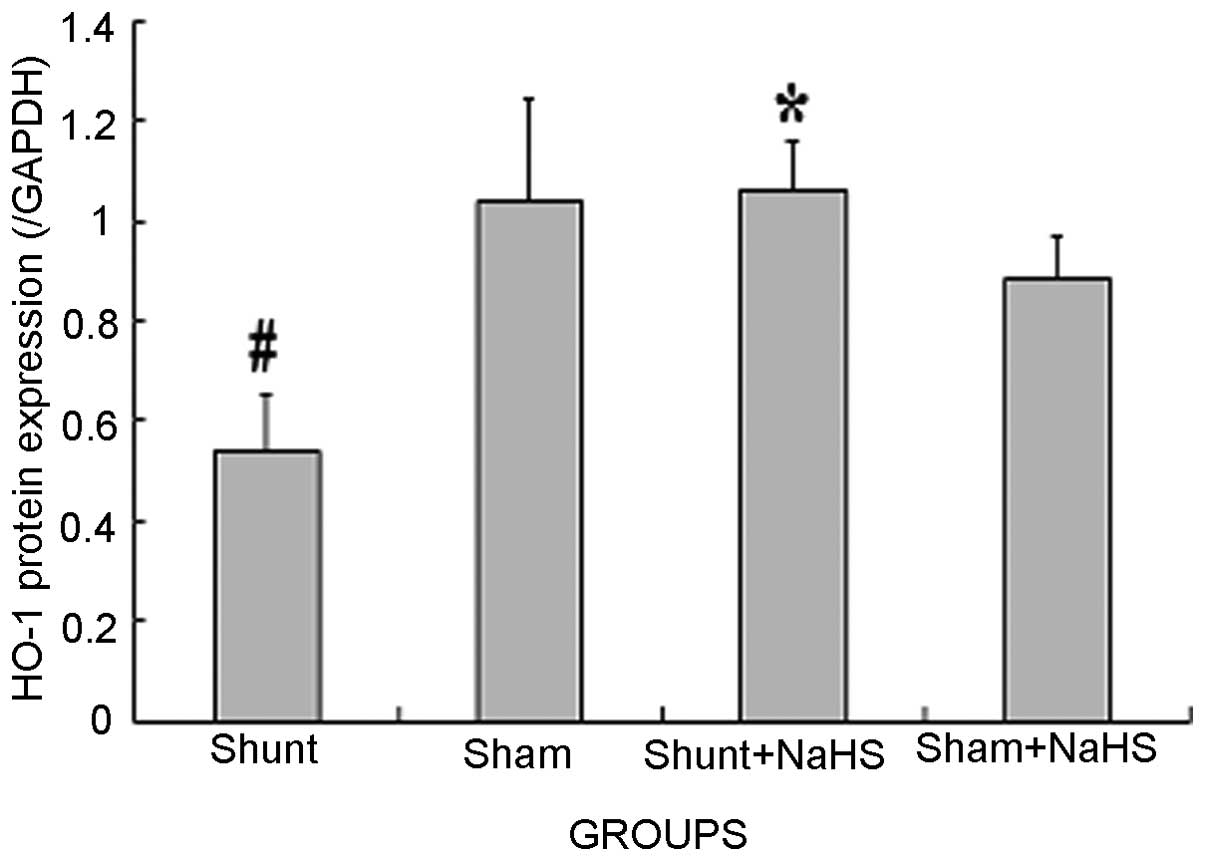|
1
|
Liu YH, Lu M, Hu LF, Wong PT, Webb GD and
Bian JS: Hydrogen sulfide in the mammalian cardiovascular system.
Antioxid Redox Signal. 17:141–185. 2012. View Article : Google Scholar : PubMed/NCBI
|
|
2
|
Ji Y, Pang QF, Xu G, Wang L, Wang JK and
Zeng YM: Exogenous hydrogen sulfide postconditioning protects
isolated rat hearts against ischemia-reperfusion injury. Eur J
Pharmacol. 587:1–7. 2008. View Article : Google Scholar
|
|
3
|
Bliksoen M, Kaljusto ML, Vaage J and
Stenslokken KO: Effects of hydrogen sulphide on
ischaemia-reperfusion injury and ischaemic preconditioning in the
isolated, perfused rat heart. Eur J Cardiothorac Surg. 34:344–349.
2008. View Article : Google Scholar
|
|
4
|
Muellner MK, Schreier SM, Laggner H, et
al: Hydrogen sulfide destroys lipid hydroperoxides in oxidized LDL.
Biochem J. 420:277–281. 2009. View Article : Google Scholar : PubMed/NCBI
|
|
5
|
Johansen D, Ytrehus K and Baxter GF:
Exogenous hydrogen sulfide (H2S) protects against
regional myocardial ischemia-reperfusion injury - Evidence for a
role of KATP channels. Basic Res Cardiol. 101:53–60.
2006.
|
|
6
|
Zhu YZ, Wang ZJ, Ho P, et al: Hydrogen
sulfide and its possible roles in myocardial ischemia in
experimental rats. J Appl Physiol. 102:261–268. 2007. View Article : Google Scholar : PubMed/NCBI
|
|
7
|
Li XH, Zhang CY and Zhang T: Sodium
hydrosulfide improves cardiac functions and structures in rats with
chronic heart failure. Zhonghua Yi Xue Za Zhi. 91:3044–3049.
2011.(In Chinese).
|
|
8
|
Peterson SJ, Frishman WH and Abraham NG:
Targeting heme oxygenase: therapeutic implications for diseases of
the cardiovascular system. Cardiol Rev. 17:99–111. 2009. View Article : Google Scholar : PubMed/NCBI
|
|
9
|
Immenschuh S and Schroder H: Heme
oxygenase-1 and cardiovascular disease. Histol Histopathol.
21:679–685. 2006.
|
|
10
|
Johnson RA, Colombari E, Columbari DS,
Lavesa M, Talman WT and Nasjletti A: Role of endogenous carbon
monoxide in central regulation of arterial pressure. Hypertension.
30:962–967. 1997. View Article : Google Scholar : PubMed/NCBI
|
|
11
|
Ndisang JF, Zhao W and Wang R: Selective
regulation of blood pressure by heme oxygenase-1 in hypertension.
Hypertension. 40:315–321. 2002. View Article : Google Scholar : PubMed/NCBI
|
|
12
|
Otterbein LE, Zuckerbraun BS, Haga M, et
al: Carbon monoxide suppresses arteriosclerotic lesions associated
with chronic graft rejection and with balloon injury. Nat Med.
9:183–190. 2003. View
Article : Google Scholar
|
|
13
|
Yet SF, Layne MD, Liu X, Chen YH, Ith B,
Sibinga NE and Perrella MA: Absence of heme oxygenase-1 exacerbates
atherosclerosis lesion formation and vascular remodeling. FASEB J.
17:1759–1761. 2003.PubMed/NCBI
|
|
14
|
Fujimoto H, Ohno M, Ayabe S, et al: Carbon
monoxide protects against cardiac ischemia - reperfusion injury in
vivo via MAPK and Akt - eNOS pathways. Arterioscler Thromb Vasc
Biol. 24:1848–1853. 2004. View Article : Google Scholar : PubMed/NCBI
|
|
15
|
Liu X, Pachori AS, Ward CA, et al: Heme
oxygenase-1 (HO-1) inhibits postmyocardial infarct remodeling and
restores ventricular function. FASEB J. 20:207–216. 2006.
View Article : Google Scholar : PubMed/NCBI
|
|
16
|
Ocampo C, Ingram P, Ilbawi M, Arcilla R
and Gupta M: Revisiting the surgical creation of volume load by
aorto-caval shunt in rats. Mol Cell Biochem. 251:139–143.
2003.PubMed/NCBI
|
|
17
|
Yan H, Du J and Tang C: The possible role
of hydrogen sulfide on the pathogenesis of spontaneous hypertension
in rats. Biochem Biophys Res Commun. 313:22–27. 2004. View Article : Google Scholar : PubMed/NCBI
|
|
18
|
Wang X, Wang Q, Guo W and Zhu YZ: Hydrogen
sulfide attenuates cardiac dysfunction in a rat model of heart
failure: a mechanism through cardiac mitochondrial protection.
Biosci Rep. 31:87–98. 2011. View Article : Google Scholar : PubMed/NCBI
|
|
19
|
Sadowski SL: Congenital cardiac disease in
the newborn infant: past, present, and future. Crit Care Nurs Clin
North Am. 21:37–48. 2009. View Article : Google Scholar : PubMed/NCBI
|
|
20
|
Ndisang JF, Tabien HE and Wang R: Carbon
monoxide and hypertension. J Hypertens. 22:1057–1074. 2004.
View Article : Google Scholar : PubMed/NCBI
|
|
21
|
Hangaishi M, Ishizaka N, Aizawa T, et al:
Induction of heme oxygenase-1 can act protectively against cardiac
ischemia/reperfusion in vivo. Biochem Biophys Res Commun.
279:582–588. 2000. View Article : Google Scholar : PubMed/NCBI
|
|
22
|
Masini E, Vannacci A, Marzocca C, et al:
Heme oxygenase-1 and the ischemia-reperfusion injury in the rat
heart. Exp Biol Med (Maywood). 228:546–549. 2003.PubMed/NCBI
|
|
23
|
Guo Y, Stein AB, Wu WJ, et al:
Administration of a CO-releasing molecule at the time of
reperfusion reduces infarct size in vivo. Am J Physiol Heart Circ
Physiol. 286:H1649–H1653. 2004. View Article : Google Scholar : PubMed/NCBI
|
|
24
|
L’Abbate A, Neglia D, Vecoli C, et al:
Beneficial effect of heme oxygenase-1 expression on myocardial
ischemia-reperfusion involves an increase in adiponectin in mildly
diabetic rats. Am J Physiol Heart Circ Physiol. 293:H3532–H3541.
2007.PubMed/NCBI
|
|
25
|
Varadi J, Lekli I, Juhasz B, et al:
Beneficial effects of carbon monoxide-releasing molecules on
post-ischemic myocardial recovery. Life Sci. 80:1619–1626. 2007.
View Article : Google Scholar : PubMed/NCBI
|
|
26
|
Wang G, Hamid T, Keith RJ, et al:
Cardioprotective and anti-apoptotic effects of heme oxygenase-1 in
the failing heart. Circulation. 121:1912–1925. 2010. View Article : Google Scholar : PubMed/NCBI
|
|
27
|
Qingyou Z, Junbao D, Weijin Z, Hui Y,
Chaoshu T and Chunyu Z: Impact of hydrogen sulfide on carbon
monoxide/heme oxygenase pathway in the pathogenesis of hypoxic
pulmonary hypertension. Biochem Biophys Res Commun. 317:30–37.
2004. View Article : Google Scholar : PubMed/NCBI
|
|
28
|
Oh GS, Pae HO, Lee BS, et al: Hydrogen
sulfide inhibits nitric oxide production and nuclear factor-kappaB
via heme oxygenase-1 expression in RAW264.7 macrophages stimulated
with lipopolysaccharide. Free Radic Biol Med. 41:106–119. 2006.
View Article : Google Scholar : PubMed/NCBI
|













